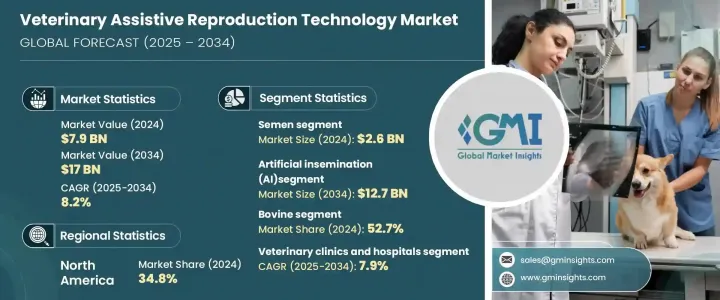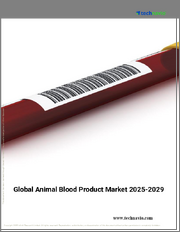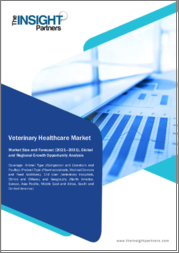
|
시장보고서
상품코드
1766349
동물용 보조생식 기술 시장 : 시장 기회, 성장 촉진요인, 산업 동향 분석, 예측(2025-2034년)Veterinary Assistive Reproduction Technology Market Opportunity, Growth Drivers, Industry Trend Analysis, and Forecast 2025 - 2034 |
||||||
세계의 동물용 보조생식 기술 시장은 2024년에는 79억 달러로 평가되었고, CAGR 8.2%로 성장할 전망이며, 2034년에는 170억 달러에 이를 것으로 추정됩니다.
이 성장의 주요 요인은 가축 두수 증가, 식육 및 유제품 수요 증가, 축산 분야에 대한 투자 확대입니다. 축산 동물의 번식 및 유전적 개량이 세계의 식량 수요를 충족시키기 위해 필수적이 됨에 따라 번식 효율, 무리의 유전, 전체적인 생산성을 향상시키기 위해 수의학적 ART 기술이 채용되고 있습니다. 우수한 유전물질을 활용해 번식주기를 강화함으로써 ART는 생우유 및 식육의 수확량을 향상시키고 나아가 세계 소비의 증가를 뒷받침합니다.

많은 국가에서는 보조금이나 축산 프로그램의 형태로 정부로부터의 지원이 있어, ART 기술의 채용을 한층 더 밀어주고 있습니다. 기타 혜택으로는 동결보존, 난자픽업(OPU), 정밀 육종 등 기술의 발전으로 ART에 대한 접근성이 향상되고 있으며, 소규모 진료소부터 대규모 농장까지 이러한 기술의 혜택을 받을 수 있게 되어 있습니다. 동물용 ART는 동물의 번식, 멸종위기종 보호, 가축의 건강 증진에 필수적인 역할을 하고 있습니다.
| 시장 범위 | |
|---|---|
| 시작 연도 | 2024년 |
| 예측 연도 | 2025-2034년 |
| 시작 금액 | 79억 달러 |
| 예측 금액 | 170억 달러 |
| CAGR | 8.2% |
정액 부문은 2024년에 26억 달러로 평가되었습니다. 정액은 인공수정(AI)에 있어 매우 중요하며, 소군의 유전자를 개선하고 자연교배와 관련된 질병을 회피하는 능력이 있기 때문에 선택적 번식 프로그램에 필수적인 요소가 되고 있습니다. 정액 기반의 ART 전략을 채택함으로써 농가와 브리더는 가축의 생산성과 수익성을 높일 수 있습니다. 동결 보존과 정액 성판별 기술의 최근 발전으로 더 나은 번식 결과를 얻을 수 있게 되었고, 정액 품질 검사 및 유통 물류의 혁신으로 이 부문의 시장 지위가 강화되었습니다. 게다가 교육 프로그램, 재정적 인센티브, 수의학적 서비스의 이용 가능성의 확대도, 업계에서 정액 베이스의 ART의 보급을 지지하고 있습니다.
인공수정(AI) 분야는 2034년까지 127억 달러에 달할 것으로 예측됩니다. AI는 다양한 동물종, 특히 축산과 낙농 분야에서 널리 이용되고 있습니다. 그 이유는 보다 효율적으로 번식을 계획하고, 여러 수컷 번식 동물의 필요성을 줄이고, 유전적으로 우수한 수컷의 범위를 원격지까지 넓힐 수 있기 때문입니다. 이 기술은 소군의 유전성을 높이고 생산성을 개선하며 내병성을 향상시켜 이 모든 것이 널리 받아들여지는 계기가 되었습니다. AI는 또 자연 번식에 비해 비용 대비 효과 및 신뢰성이 높고 상해나 질병 감염 위험이 낮기 때문에 농가나 번식업자에게 좋은 선택지로 여겨지고 있습니다. 가축의 생산성을 높이는 것을 목적으로 한 정부나 비정부의 프로그램은 AI 기술의 채택을 더욱 가속화시키고 있습니다.
미국의 동물용 보조생식 기술 2024년 시장 규모는 25억 달러로 평가되었습니다. 이 나라는 세계의 동물용 보조생식 기술 시장의 주요 기업이며, 세련된 수의 건강 인프라 및 고도 생식 기술의 높은 도입율에 견인되고 있습니다. 미국의 동물 병원은 인공수정, 배이식, 체외 영리 목적의 번식 사업에서는 유전적 품질의 향상과 질병의 억제를 위해 ART를 활용하는 경우가 늘어나고 있으며, 소군의 건강 증진으로 이어지고 있습니다. 또한, 미국에는 공급자나 서비스 제공업체의 강력한 네트워크가 있기 때문에 ART 제품이나 서비스에의 액세스가 향상해, 시장 성장을 뒷받침하고 있습니다.
세계 동물용 보조생식 기술 시장의 주요 기업으로는 Minitube Group, IMV Technologies, Genus Plc, CRV Holdings, Bovine Elite, Select Sires, STgenetics, SEMEX, Swine Genetics International, Geno SA, VikingGenetics, URUS Group 등이 있습니다. 전략면에서는 동물용 보조생식 기술 시장의 기업은 시장 포지션을 강화하기 위해 제품 포트폴리오의 확대와 서비스 제공의 강화에 주력하고 있습니다. 주요 전략에는 고급 정액 동결 보존 기술, 배아 이식 기술, 정밀 육종 도구 등의 혁신적 솔루션 개발이 포함됩니다. 연구 기관이나 동물 병원과의 제휴도, 특히 신흥 시장에 있어 ART 서비스의 이용 용이성과 유효성을 높이는데 있어서 중요한 역할을 하고 있습니다. 또, 기업은 교육적 대처에도 고액의 투자를 실시하고 있어, 이러한 기술의 전체적인 채용을 향상시키기 위해서, 수의사 전문가 전용의 연수 프로그램을 제공하고 있습니다. 또한 아시아태평양과 라틴 아메리카 등 축산 인구가 증가하고 식육과 유제품 수요가 높아지고 있는 지역을 타깃으로 하여 지리적 확대에 주력하고 있는 기업도 있습니다.
목차
제1장 조사 방법 및 범위
제2장 주요 요약
제3장 업계 인사이트
- 생태계 분석
- 공급자의 상황
- 각 단계에서의 부가가치
- 밸류체인에 영향을 주는 요인
- 업계에 미치는 영향요인
- 성장 촉진요인
- 동물 사육 수요 증가
- 수의학의 진보
- 유전자 보존 중시
- 동물용 헬스케어비 증가
- 업계의 잠재적 위험 및 과제
- 첨단 생식기술과 관련된 높은 초기 도입 비용
- 수술 실패 및 합병증의 위험
- 시장 기회
- 유전체 선발 및 정밀 육종의 통합
- 멸종위기종 보호 및 번식에 대한 수요 증가
- 성장 촉진요인
- 성장 가능성 분석
- 규제 상황
- 기술의 상황
- 현재의 기술 동향
- 신흥 기술
- 장래 시장 동향
- Porter's Five Forces 분석
- PESTEL 분석
제4장 경쟁 구도
- 서문
- 기업 매트릭스 분석
- 주요 시장 기업의 경쟁 분석
- 경쟁 포지셔닝 매트릭스
- 전략 대시보드
제5장 시장 추계 및 예측 : 유형별(2021-2034년)
- 주요 동향
- 서비스
- 정액
- 정상적인 정액
- 성별 판정 정액
- 기기
- 키트 및 소모품
제6장 시장 추계 및 예측 : 기술별(2021-2034년)
- 주요 동향
- 인공수정(AI)
- 체외수정(IVF)(IVF)
- 배아 이식(MOET)
- 기타 기술
제7장 시장 추계 및 예측 : 동물 유형별(2021-2034년)
- 주요 동향
- 소
- 돼지
- 양
- 염소
- 말
- 기타 동물 유형
제8장 시장 추계 및 예측 : 최종 용도별(2021-2034년)
- 주요 동향
- 수의사 클리닉 및 병원
- 동물 사육 센터
- 연구기관 및 대학
- 기타 용도
제9장 시장 추계 및 예측 : 지역별(2021-2034년)
- 주요 동향
- 북미
- 미국
- 캐나다
- 유럽
- 독일
- 영국
- 프랑스
- 이탈리아
- 스페인
- 폴란드
- 네덜란드
- 아시아태평양
- 중국
- 일본
- 인도
- 호주
- 한국
- 라틴아메리카
- 브라질
- 멕시코
- 중동 및 아프리카
- 남아프리카
- 사우디아라비아
- 아랍에미리트(UAE)
제10장 기업 프로파일
- Bovine Elite
- CRV Holdings
- Geno SA
- Genus Plc
- IMV Technologies
- Minitube Group
- SEMEX
- Select Sires
- Swine Genetics International
- STgenetics
- URUS Group
- VikingGenetics
The Global Veterinary Assistive Reproduction Technology Market was valued at USD 7.9 billion in 2024 and is estimated to grow at a CAGR of 8.2% to reach USD 17 billion by 2034. This growth is primarily driven by the rising livestock population, an increasing demand for meat and dairy products, and greater investments in the livestock sector. As breeding and genetic improvement in livestock animals become more critical to meeting global food demand, veterinary ART technologies are being adopted to improve reproductive efficiency, herd genetics, and overall productivity. By leveraging superior genetic materials and enhancing breeding cycles, ART helps to boost yields of milk and meat, which in turn supports rising global consumption.

In many countries, governmental support in the form of subsidies and livestock programs further drives the adoption of ART technologies. Additionally, ongoing technological advancements, including cryopreservation, ovum pick-up (OPU), and precision breeding, are improving accessibility to ART, enabling small clinics and large farms alike to benefit from these technologies. Veterinary ART plays an essential role in animal breeding, the conservation of endangered species, and the improvement of livestock health.
| Market Scope | |
|---|---|
| Start Year | 2024 |
| Forecast Year | 2025-2034 |
| Start Value | $7.9 Billion |
| Forecast Value | $17 Billion |
| CAGR | 8.2% |
The semen segment was valued at USD 2.6 billion in 2024. Semen is crucial in artificial insemination (AI) and has become an integral part of selective breeding programs due to its ability to improve herd genetics and avoid diseases associated with natural mating. The adoption of semen-based ART strategies enables farmers and breeders to enhance livestock productivity and profitability. Recent advancements in cryopreservation and semen sexing technologies have made it possible to achieve better breeding results, and innovations in semen quality testing and distribution logistics have bolstered the segment's market position. Furthermore, educational programs, financial incentives, and the growing availability of veterinary services are also supporting the widespread use of semen-based ART in the industry.
Artificial insemination (AI) segment is expected to reach USD 12.7 billion by 2034. AI is widely used in various animal species, particularly in livestock and dairy sectors, for its ability to schedule breeding more effectively, reduce the need for multiple male breeding animals, and extend the reach of genetically superior males to remote locations. The technology has enhanced herd genetics, improved productivity, and increased disease resistance, all of which have led to its widespread acceptance. AI is also considered more cost-effective, and reliable, and carries a lower risk of injury and disease transmission compared to natural breeding, making it a preferred option for farmers and breeders. Government and non-governmental programs designed to boost livestock productivity further accelerate the adoption of AI technologies.
U.S. Veterinary Assistive Reproduction Technology Market was valued at USD 2.5 billion in 2024. The country is a key player in the global veterinary assistive reproduction technology market, driven by a sophisticated veterinary healthcare infrastructure and high adoption of advanced reproductive technologies. Veterinary clinics in the U.S. are equipped with state-of-the-art facilities to perform ART procedures such as AI, embryo transfer, and in vitro fertilization. Commercial breeding operations are increasingly utilizing ART to improve genetic quality and control diseases, leading to better herd health. Additionally, a strong network of suppliers and service providers in the U.S. increases accessibility to ART products and services, propelling market growth.
Key players in the Global Veterinary Assistive Reproduction Technology Market include Minitube Group, IMV Technologies, Genus Plc, CRV Holdings, Bovine Elite, Select Sires, STgenetics, SEMEX, Swine Genetics International, Geno SA, VikingGenetics, and URUS Group. In terms of strategies, companies in the veterinary assistive reproduction technology market focus on expanding their product portfolios and enhancing service offerings to strengthen their market position. Key strategies include developing innovative solutions such as advanced semen cryopreservation techniques, embryo transfer technologies, and precision breeding tools. Partnerships with research institutions and veterinary clinics also play a significant role in increasing the accessibility and effectiveness of ART services, especially in emerging markets. Companies are also investing heavily in educational initiatives, providing training programs for veterinary professionals to improve the overall adoption of these technologies. Furthermore, some companies are focusing on geographical expansion by targeting regions with growing livestock populations and rising demand for meat and dairy products, such as Asia-Pacific and Latin America.
Table of Contents
Chapter 1 Methodology and Scope
- 1.1 Market scope and definition
- 1.2 Research design
- 1.2.1 Research approach
- 1.2.2 Data collection methods
- 1.3 Data mining sources
- 1.3.1 Global
- 1.3.2 Regional/country
- 1.4 Base estimates and calculations
- 1.4.1 Base year calculation
- 1.4.2 Key trends for market estimation
- 1.5 Primary research and validation
- 1.5.1 Primary sources
- 1.6 Forecast model
- 1.7 Research assumptions and limitations
Chapter 2 Executive Summary
- 2.1 Industry 3600 synopsis
- 2.2 Key market trends
- 2.2.1 Regional
- 2.2.2 Type
- 2.2.3 Technology
- 2.2.4 Animal type
- 2.2.5 End use
- 2.3 CXO perspectives: Strategic imperatives
- 2.3.1 Key decision points for industry executives
- 2.3.2 Critical success factors for market players
- 2.4 Future outlook and strategic recommendations
Chapter 3 Industry Insights
- 3.1 Industry ecosystem analysis
- 3.1.1 Supplier landscape
- 3.1.2 Value addition at each stage
- 3.1.3 Factors affecting the value chain
- 3.2 Industry impact forces
- 3.2.1 Growth drivers
- 3.2.1.1 Rising demand for animal breeding
- 3.2.1.2 Advancements in veterinary medicine
- 3.2.1.3 Focus on genetic preservation
- 3.2.1.4 Increasing veterinary healthcare expenditure
- 3.2.2 Industry pitfalls and challenges
- 3.2.2.1 High initial setup costs associated with advanced reproductive technologies
- 3.2.2.2 Risk of procedural failures and complications
- 3.2.3 Market opportunities
- 3.2.3.1 Integration of genomic selection and precision breeding
- 3.2.3.2 Rising demand for conservation and endangered species breeding
- 3.2.1 Growth drivers
- 3.3 Growth potential analysis
- 3.4 Regulatory landscape
- 3.4.1 North America
- 3.4.2 Europe
- 3.4.3 Asia Pacific
- 3.4.4 Latin America
- 3.4.5 Middle East and Africa
- 3.5 Technology landscape
- 3.5.1 Current technological trends
- 3.5.2 Emerging technologies
- 3.6 Future market trends
- 3.7 Porter's analysis
- 3.8 PESTEL analysis
Chapter 4 Competitive Landscape, 2024
- 4.1 Introduction
- 4.2 Company matrix analysis
- 4.3 Competitive analysis of major market players
- 4.4 Competitive positioning matrix
- 4.5 Strategy dashboard
Chapter 5 Market Estimates and Forecast, By Type, 2021 - 2034 ($ Mn)
- 5.1 Key trends
- 5.2 Services
- 5.3 Semen
- 5.3.1 Normal semen
- 5.3.2 Sexed semen
- 5.4 Instruments
- 5.5 Kits and consumables
Chapter 6 Market Estimates and Forecast, By Technology, 2021 - 2034 ($ Mn)
- 6.1 Key trends
- 6.2 Artificial insemination (AI)
- 6.3 In vitro fertilization (IVF)
- 6.4 Embryo transfer (MOET)
- 6.5 Other technologies
Chapter 7 Market Estimates and Forecast, By Animal Type, 2021 - 2034 ($ Mn)
- 7.1 Key trends
- 7.2 Bovine
- 7.3 Swine
- 7.4 Ovine
- 7.5 Caprine
- 7.6 Equine
- 7.7 Other animal types
Chapter 8 Market Estimates and Forecast, By End Use, 2021 - 2034 ($ Mn)
- 8.1 Key trends
- 8.2 Veterinary clinics and hospitals
- 8.3 Animal breeding centers
- 8.4 Research institutes and universities
- 8.5 Other end use
Chapter 9 Market Estimates and Forecast, By Region, 2021 - 2034 ($ Mn)
- 9.1 Key trends
- 9.2 North America
- 9.2.1 U.S.
- 9.2.2 Canada
- 9.3 Europe
- 9.3.1 Germany
- 9.3.2 UK
- 9.3.3 France
- 9.3.4 Italy
- 9.3.5 Spain
- 9.3.6 Poland
- 9.3.7 Netherlands
- 9.4 Asia Pacific
- 9.4.1 China
- 9.4.2 Japan
- 9.4.3 India
- 9.4.4 Australia
- 9.4.5 South Korea
- 9.5 Latin America
- 9.5.1 Brazil
- 9.5.2 Mexico
- 9.6 Middle East and Africa
- 9.6.1 South Africa
- 9.6.2 Saudi Arabia
- 9.6.3 UAE
Chapter 10 Company Profiles
- 10.1 Bovine Elite
- 10.2 CRV Holdings
- 10.3 Geno SA
- 10.4 Genus Plc
- 10.5 IMV Technologies
- 10.6 Minitube Group
- 10.7 SEMEX
- 10.8 Select Sires
- 10.9 Swine Genetics International
- 10.10 STgenetics
- 10.11 URUS Group
- 10.12 VikingGenetics



















